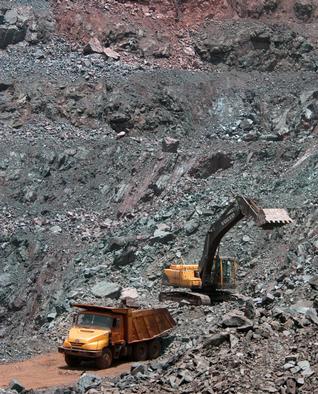 BANGALORE, June 17;The epic proportions of the illegal mining scam that was uncovered by the Karnataka Lokayukta in its 2011 report may actually have been just one act of a much larger, more complex and multi-layered drama.
BANGALORE, June 17;The epic proportions of the illegal mining scam that was uncovered by the Karnataka Lokayukta in its 2011 report may actually have been just one act of a much larger, more complex and multi-layered drama.
There is now new evidence to suggest that the Lokayukta’s final report on illegal mining – a political game-changer that sent the powerful to jail and catalysed a regime change in the state – is just one part of the mining story. A six-month-long investigation by The Hindu, with help from whistleblowers in the Railways, the Karnataka Commercial Taxes Department and the CBI, points to losses to the State exchequer between January 2006 and December 2010 that are, at the very least, Rs. 1 lakh crore or eight times the estimated figure given in the Lokayukta report. The investigation also shows that the State lost Rs. 2,000 crore in commercial taxes.
The new information suggests that the dominant narrative on illegal mining, namely, that illegal ore was mainly exported to China to feed an infrastructure boom triggered by the Beijing Olympics, is actually a very partial telling of the mining scam story. The new data with The Hindu furthers the depth and reach of the mining scam, a part of which was so exhaustively covered in the Lokayukta report.
Some our central findings are as follows.
The Lokayukta report says that 12.57 crore tonnes of iron ore was exported overseas from Karnataka between 2006 and 2010. However, documents with The Hindu reveal that nearly 35 crore tonnes of ore was transported out of Bellary in the same period. If one were to deduct the 12.57 crore tonnes exported (as per Lokayukta report), the remaining the 22.43 crore tonnes was sold in the domestic market.
The Lokayukta report estimates the losses to the exchequer at Rs. 12,228 crore. The organisation’s calculation was based on the fact that the government had given permits for extraction for only 9.58 crores tonnes of ore. Subtracted from the 12.57 crore tonnes exported, it meant that 2.98 crore tonnes of ore was illegally mined and exported. The Lokayukta estimated the price of ore exported at an average of Rs. 4,103 per tonne.
What explains the divergence between the findings of the Lokayukta and those of The Hindu? The Lokayukta has relied on Customs Department data on ore shipments exported from 10 ports in Karnataka, Goa, Tamil Nadu and Andhra Pradesh between 2006 and 2010, to calculate the quantum of ore that left the country.
By contrast, The Hindu has looked at the total quantity of ore transported out of Bellary by road and rail. Railway documents show that 20 crore tonnes of iron ore was transported out of Bellary from six railway stations and 14 railway sidings between 2006 and 2010. Of this, nearly 19 crore tonnes of ore was marked “for export”.
From data sources in the CBI and Commercial Taxes Department, we know that lorries carried at least 14 crore tonnes of ore out of Bellary by road in the nine months between September 2009 and June 2010. “This was when the Bellary [Reddy] brothers had rebelled against B.S. Yeddyurappa’s government. The rebellion was a smokescreen to intensify illegal mining. At least 20,000 trucks were leaving Bellary each day in that period,” a CBI official told The Hindu.
Leaving out these nine months, on each day between 2006 and 2010 an average of 1,000 lorries left Bellary, with an average load of 32 tonnes of ore per truck. This adds nearly another 4 crore tonnes to the overall tally.
Therefore nearly 35 crore tonnes of iron ore was transported from Bellary in four years time by lorries and railway wagons.
Officers in the Commercial Taxes Department and the CBI concur on the point that 35 crore tonnes of ore could not have been exported from the ports near Bellary. “All the 10 ports [from where stolen ore was being exported] put together simply don’t have the capacity to handle such massive traffic,” said one Commercial Taxes officer.
These sources agree with the Lokayukta report to the extent that only 12.57 tonnes was actually exported. “On this count, the Lokayukta report is accurate as it is Customs Department data on which the report is based,” said an officer.
However, the remaining 22.43 crore tonnes of ore, although marked “for export”, was supplied domestically, he says. This, the officer claims, was done to evade commercial taxes.
